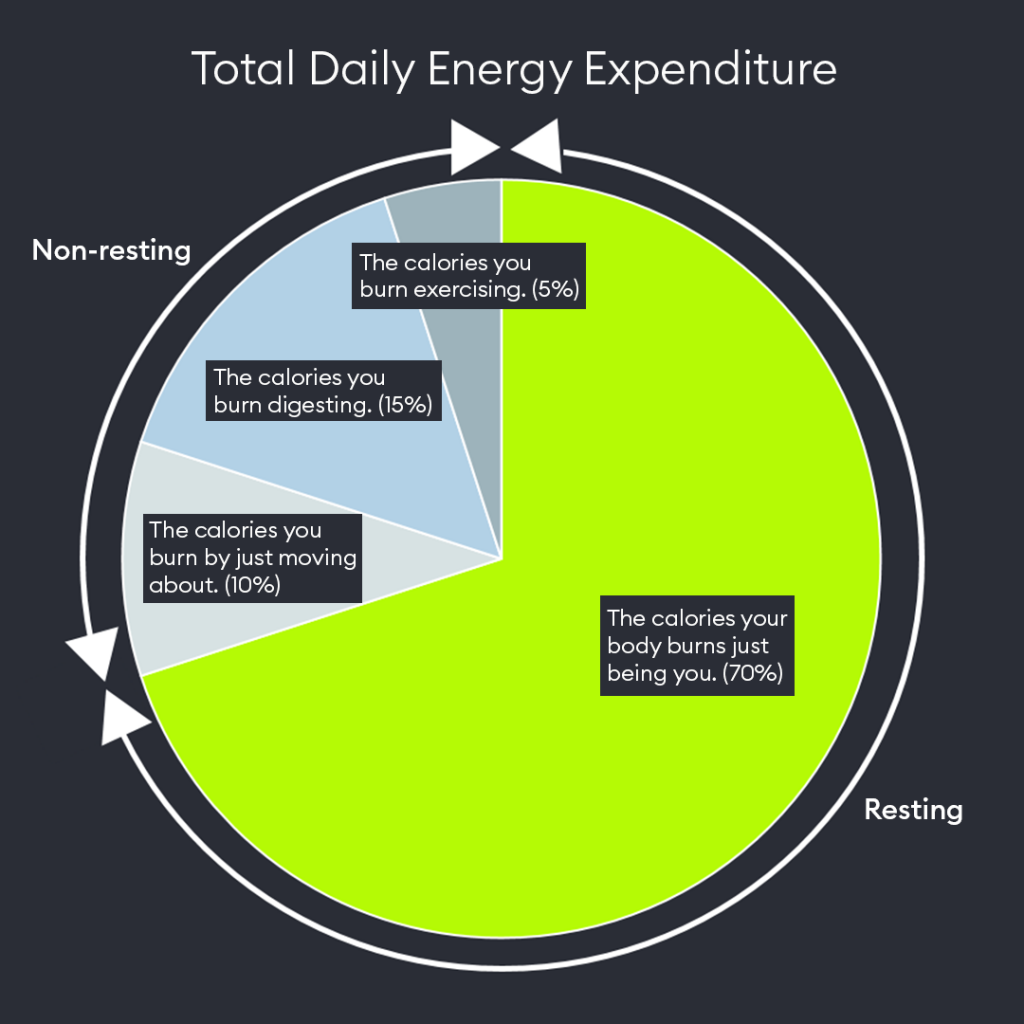You might have heard of metabolic age. You might not. It’s not a common measurement for health and fitness, but if you’ve ever stepped on one of those smart scales in the gym, it’s a reading you might be familiar with.
There’s a continual stream of new targets and measurements to focus on regarding fitness. And many of them are incredibly unhelpful (we’re looking at you BMI).
So, what is metabolic age and is it something worth your concern?
Are you an employer? Hussle now offer flexible, discounted access to our fitness venues as an employee benefit. Elevate employee wellbeing.
Firstly, what is metabolism?
Metabolism describes all the essential chemical processes that go on inside your body to keep you alive. The ones you can’t control and don’t really even notice. Lungs breathing, heart beating, brain thinking, stomach digesting. The list is complex and endless.
The key point is that metabolic processes require energy. You get this energy from the food you eat, measured in the form of calories.
Your Basal Metabolic Rate (BMR) is the number of calories your body needs. It’s the amount of energy it takes to carry out all of these different processes. It’s the number of calories you need when at complete rest, so doesn’t include any of the extra energy required for the daily movement you do.
Your BMR is specific to you. No blanket figure applies to everyone, because each body needs a different number of calories per day to carry out its metabolic processes.
A ‘slow metabolism’ is used to describe a low BMR. This means the body needs fewer calories to carry out its processes. A ‘faster metabolism’ is used to describe a high BMR.
It’s worth remembering that BMR doesn’t include the amount of physical activity you do. Day-to-day, you can’t control the number of calories your body burns doing its everyday processes (BMR), but you can manage the number is burns through movement.

What affects your metabolism?
Your BMR is influenced by your age, sex, height and body mass. When it comes to metabolism, there are loads of individual differences, but as a general rule:
The younger you are, the faster your metabolism.
Males have faster metabolisms than females.
The taller you are, the faster your metabolism.
And the larger your body mass, the faster your metabolism.
For this reason, all of these variables are included in the calculation for estimated BMR:
For males: 66.5 + (13.75 x kg) + (5.003 x cm) – (6.775 x age)
For females: 655.1 + (9.563 x kg) + (1.850 x cm) – (4.676 x age)
It’s worth pointing out that other factors influence your metabolism, which aren’t included in the calculation.
Your body composition is a big one. Muscle tissue requires more energy to maintain than fat tissue. You might weigh 80kg, but this says nothing about whether that bodyweight is made up more from fat or more from muscle.
Genetics play a role in your metabolism too. This means you can have a faster than average or slower than average metabolism for your demographic and size.
For these reasons, calculating metabolism or BMR can be tricky. As a concept, it’s a reliable source of information, but as a calculation, it can be hard to get right.
So, what is metabolic age?
As mentioned, your age dictates, to an extent, how fast your metabolism is. In your younger years, it’s a lot quicker.
Your metabolic age parallels your current BMR to the average for age. It takes your BMR and relates it to the average for chronological ages. In this way, it can give you an insight into how your BMR sits compared to others your age.
If your metabolic age is lower than your real age, it suggests you have a faster than average metabolism. If your metabolic age is higher than your actual age, it means its much slower.
How do you calculate metabolic age?
There isn’t a basic calculation for metabolic age as there is for BMR. Because it’s a figure that aims to be much more specific to you, it doesn’t help to take the average figures for sex, age, height, and weight, and make a prediction.
The technology used to calculate your metabolic age will likely try and measure your body composition. It’s informed by the percentage of body fat and muscle mass you have, giving a more reliable prediction of your health and fitness on the inside than BMR can.
How can you decrease your metabolic age?
A good metabolic age is your age in real life. If you’re 40, your metabolic age should really be 40 too. Those that are fitter will find their metabolic age reads much younger than their chronological age.
To decrease your metabolic age, you need to reduce the percentage of body fat and increase the percentage of muscle mass you’re made from.
The tips for doing this are similar to most advice for weight loss or muscle conditioning:
1. Move more often
This isn’t referring to purposeful runs or gym-based exercises. This is just about moving more in general. Increasing the amount of physical activity you do in a day is the easiest way to burn calories and lose weight.
Taking the stairs, cleaning the house, walking to the shops, even just standing up more often. Being aware of our increasingly sedentary lifestyles and choosing to move more often is the first step towards improved health and fitness.
2. Increase your exercise frequency
When you do purposeful exercise that gets your heart rate up and your muscles moving, aim for x2 times per week to start. This is a challenging but sustainable amount of exercise for beginners. It offers you plenty of rest between sessions but gives you a regular routine to kickstart your fitness progression.
3. Count your calories
Regardless of how much exercise you’re doing, if you’re not aware of the number of calories going in, it doesn’t matter how many are burned.
Counting your calories brings awareness to the amount of energy you’re giving your body each day. It might shed light on why weight loss hasn’t happened for you so far because the exclusive rule to fat loss is creating a calorie deficit. More energy must be given out than taken in.
Do note, that fat loss to reduce metabolic age might only help those who are overweight. Otherwise, it’s worth focusing on increasing muscle mass instead.
4. Eat a balanced plate of proteins, carbs, and fats
The best way to improve your diet is to make it balanced. Nutritional guidelines recommend that your diet is made up of 45-65% carbs, 10-35% protein and 20-35% fat.
If you’re exercising regularly, you need to prioritise protein even more. Go for high quality and organic sources of eggs, milk, chicken, fish, beef, soy, rice, and quinoa. Yoghurt, beans, and legumes are good options too.
5. Resistance train regularly
The best way to improve your percentage of muscle mass is by resistance training.
Although cardiovascular exercise is important, resistance training will have the most impact on your body composition.
Start resistance training. Using can be light dumbbells or even resistance bands, incorporating some full-body compound exercises into your fitness routine will have the best effect.
Is metabolic age worth measuring?
Metabolic age isn’t a medically recognised metric. It gives an insight into where your health and fitness might sit compared to the average for your age, but there are some issues with it.
Firstly, it can’t be considered entirely accurate. The reading needs to be taken with a pinch of salt. Unfortunately, the technology doesn’t exist that can be certain on your exact body composition, and it doesn’t consider other genetic factors.
Secondly, only you know as an individual if you’re healthy and fit enough. You’ve got to decide that for yourself, depending on what you want to be able to do and how you feel. Fitness means something different to everyone, and each individual sets their own standards for it.
Regular exercise brings with it a whole host of benefits and is worth bringing into your life. But the extent to which you do this, and the reasons why are completely up to you.
The general advice is to eat a balanced diet, move more regularly, and exercise in a way that allows you to live your life to the fullest.



